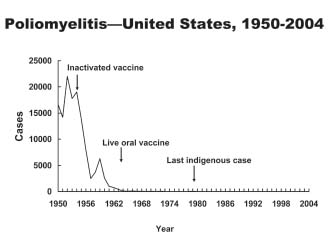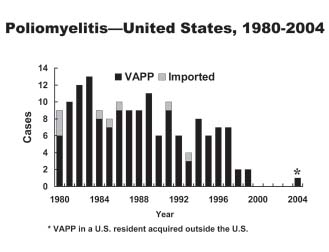Polio epidemiology and demographics: Difference between revisions
No edit summary |
No edit summary |
||
| Line 3: | Line 3: | ||
{{CMG}} | {{CMG}} | ||
== Epidemiology and Demographics == | == Epidemiology and Demographics == | ||
| Line 49: | Line 48: | ||
{{Reflist|2}} | {{Reflist|2}} | ||
[[Category:Needs overview]] | |||
[[Category:Disease]] | [[Category:Disease]] | ||
[[Category:Infectious disease]] | [[Category:Infectious disease]] | ||
Revision as of 20:59, 7 December 2012
|
Polio Microchapters |
|
Causes |
|---|
|
Diagnosis |
|
Treatment |
|
Case Studies |
|
Polio epidemiology and demographics On the Web |
|
American Roentgen Ray Society Images of Polio epidemiology and demographics |
|
Risk calculators and risk factors for Polio epidemiology and demographics |
Editor-In-Chief: C. Michael Gibson, M.S., M.D. [1]
Epidemiology and Demographics
Occurrence
At one time poliovirus infection occurred throughout the world. Transmission of wild poliovirus was interrupted in the United States in 1979, or possibly earlier. A polio eradication program conducted by the Pan American Health Organization led to elimination of polio in the Western Hemisphere in 1991. The Global Polio Eradication Program has dramatically reduced poliovirus transmission throughout the world. In 2005, only 1,948 confirmed cases of polio were reported globally and polio was endemic in six countries.
Poliovirus infection typically peaks in the summer months in temperate climates. There is no seasonal pattern in tropical climates.
Transmission
Person-to-person spread of poliovirus via the fecal-oral route is the most important route of transmission, although the oral-oral route may account for some cases.
Poliomyelitis is highly contagious and spreads easily from human-to-human contact.[1] In endemic areas, wild polioviruses can infect virtually the entire human population.[2] It is seasonal in temperate climates, with peak transmission occurring in summer and autumn.[1] These seasonal differences are far less pronounced in tropical areas.[2] The time between first exposure and first symptoms, known as the incubation period, is usually 6 to 20 days, with a maximum range of 3 to 35 days.[3] Virus particles are excreted in the feces for several weeks following initial infection.[3] The disease is transmitted primarily via the fecal-oral route, by ingesting contaminated food or water. It is occasionally transmitted via the oral-oral route,[4] a mode especially visible in areas with good sanitation and hygiene.[1] Polio is most infectious between 7–10 days before and 7–10 days after the appearance of symptoms, but transmission is possible as long as the virus remains in the saliva or feces.[4]
Factors that increase the risk of polio infection or affect the severity of the disease include immune deficiency,[5] malnutrition,[6] tonsillectomy,[7] physical activity immediately following the onset of paralysis,[8] skeletal muscle injury due to injection of vaccines or therapeutic agents,[9] and pregnancy.[10] Although the virus can cross the placenta during pregnancy, the fetus does not appear to be affected by either maternal infection or polio vaccination.[11] Maternal antibodies also cross the placenta, providing passive immunity that protects the infant from polio infection during the first few months of life.[12]
Reservoir
Humans are the only known reservoir of poliovirus, which is transmitted most frequently by persons with inapparent infections. There is no asymptomatic carrier state except in immune deficient persons.
Secular Trends in the United States
Before the 18th century, polioviruses probably circulated widely. Initial infections with at least one type probably occurred in early infancy, when transplacentally acquired maternal antibodies were high. Exposure throughout life probably provided continual boosting of immunity, and paralytic infections were probably rare. (This view has been recently challenged based on data from lameness studies in developing countries.)
In the immediate prevaccine era, improved sanitation allowed less frequent exposure and increased the age of primary infection. Boosting of immunity from natural exposure became more infrequent and the number of susceptible persons accumulated, ultimately resulting in the occurrence of epidemics, with 13,000 to 20,000 paralytic cases reported annually.
In the early vaccine era, the incidence dramatically decreased after the introduction of inactivated polio vaccine (IPV) in 1955. The decline continued following oral polio vaccine (OPV) introduction in 1961. In 1960, a total of 2,525 paralytic cases were reported, compared with 61 in 1965.
The last cases of paralytic poliomyelitis caused by endemic transmission of wild virus in the United States were in 1979, when an outbreak occurred among the Amish in several Midwest states. The virus was imported from the Netherlands. From 1980 through 1999, a total of 152 confirmed cases of paralytic poliomyelitis were reported, an average of 8 cases per year. Six cases were acquired outside the United States and imported. The last imported case was reported in 1993. Two cases were classified as indeterminant (no poliovirus isolated from samples obtained from the patients, and patients had no history of recent vaccination or direct contact with a vaccine recipient). The remaining 144 (95%) cases were vaccine-associated paralytic polio (VAPP) caused by live oral polio vaccine.
In order to eliminate VAPP from the United States, ACIP recommended in 2000 that IPV be used exclusively in the United States. The last case of VAPP acquired in the United States was reported in 1999. In 2005, an unvaccinated U.S. resident was infected with polio vaccine virus in Costa Rica and subsequently developed VAPP. Also in 2005, several asymptomatic infections with a vaccine-derived poliovirus were detected in unvaccinated children in Minnesota. The source of the vaccine virus has not been determined, but it appeared to have been circulating among humans for at least 2 years based on genetic changes in the virus. No VAPP has been reported from this virus.


References
- ↑ 1.0 1.1 1.2 Kew O, Sutter R, de Gourville E, Dowdle W, Pallansch M (2005). "Vaccine-derived polioviruses and the endgame strategy for global polio eradication". Annu Rev Microbiol. 59: 587–635. PMID 16153180.
- ↑ 2.0 2.1 Parker SP (ed.) (1998). McGraw-Hill Concise Encyclopedia of Science & Technology. New York: McGraw-Hill. p. 67. ISBN 0-07-052659-1.
- ↑ 3.0 3.1 Racaniello V (2006). "One hundred years of poliovirus pathogenesis". Virology. 344 (1): 9–16. PMID 16364730.
- ↑ 4.0 4.1 Ohri, Linda K. (1999). "Polio: Will We Soon Vanquish an Old Enemy?". Drug Benefit Trends. 11 (6): 41–54. Retrieved 2007-11-06. Unknown parameter
|coauthors=ignored (help) (Available free on Medscape; registration required.) - ↑ Davis L, Bodian D, Price D, Butler I, Vickers J (1977). "Chronic progressive poliomyelitis secondary to vaccination of an immunodeficient child". N Engl J Med. 297 (5): 241–5. PMID 195206.
- ↑ Chandra R (1975). "Reduced secretory antibody response to live attenuated measles and poliovirus vaccines in malnourished children". Br Med J. 2 (5971): 583–5. PMID 1131622.
- ↑ Miller A (1952). "Incidence of poliomyelitis; the effect of tonsillectomy and other operations on the nose and throat". Calif Med. 77 (1): 19–21. PMID 12978882.
- ↑ Horstmann D (1950). "Acute poliomyelitis relation of physical activity at the time of onset to the course of the disease". J Am Med Assoc. 142 (4): 236–41. PMID 15400610.
- ↑ Gromeier M, Wimmer E (1998). "Mechanism of injury-provoked poliomyelitis". J. Virol. 72 (6): 5056–60. PMID 9573275.
- ↑ Evans C (1960). "Factors influencing the occurrence of illness during naturally acquired poliomyelitis virus infections" (PDF). Bacteriol Rev. 24 (4): 341–52. PMID 13697553.
- ↑ Joint Committee on Vaccination and Immunisation (Salisbury A, Ramsay M, Noakes K (eds.) (2006). Chapter 26:Poliomyelitis. in: Immunisation Against Infectious Disease, 2006 (PDF). Edinburgh: Stationery Office. pp. 313–29. ISBN 0-11-322528-8.
- ↑ Sauerbrei A, Groh A, Bischoff A, Prager J, Wutzler P (2002). "Antibodies against vaccine-preventable diseases in pregnant women and their offspring in the eastern part of Germany". Med Microbiol Immunol. 190 (4): 167–72. PMID 12005329.